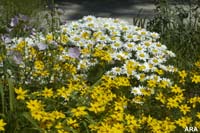|
|
Dreaming of Green - A Garden Design and Care Primer(ARA) - Green is the buzzword for today's gardener and landscaper. What is green gardening? Does walking into a nursery or browsing through plant catalogs give you a headache? Do you wonder how can you get your plants to look like, or somewhat like, those in the catalogs? Planning next season's garden does not need to be a chore. Getting your plants to respond well is within your ability. Several general steps, some that you are probably already doing, can get you the results you want. DesigningDraw a diagram of your lot. Include your house, drive, walks, patios and other hardscape (permanent) fixtures. Also, include any buried pipes and wires, plus any overhead wires that may interfere with any work you will do. This map of hardscape features is the backbone of your design.
Walk around and view different parts of your landscape. Take note of the paths you use and the views from these areas. Go to places from where you will view your plant beds, including inside your house. How wide is your view? How deep is it? Is it shady (lighten the area with light colored shade plants) or sunny? Measure the size of these planting beds. Choosing PlantsNow you are ready to select plants. Remember, you are the one who will be looking at these plants. So pick plants that you will enjoy! * Annual plants generally have more color and "pop." Perennials provide stability and anchor your landscape design. * Do you want to vary color, leaf size (plant texture), height and density, to create distinctive design areas or do you want a smooth flow? * Consider the soil type, slope, and micro-climate for each part of your yard. These will help you decide on which plants will do well for each part of your yard. * How much work and money do you want to put into your landscape? You can be green without spending lots of green! Reaching PotentialBeing a green gardener means choosing plants for each micro-climate in your yard. Plants that are "happy" where they live require less care and maintenance than those who are forced into areas where they do not belong. WateringEach variety of plant has its own needs as to frequency and amount of watering. For easier care, put plants with similar water requirements near each other. Green gardeners water only to the needs of the plant, deducting rainfall from these watering needs. "Deep watering" means watering to full rooting depth. This encourages deep rooting. It is done relatively infrequently. Let the soil dry out somewhat between waterings. These are a green gardener's choice. "Frequent watering" usually means the plant has shallow roots or is a big user of water. Daily watering of these plants may be necessary during hot, dry summer weather. FertilizingLandscape plants respond very well to fertilizers with a high percent of slow-release organic nitrogen. This slow-release nitrogen gradually releases as plants need it. Plants aren't "pushed" to grow faster than they should, and don't end up with unsightly, leggy growth. Fertilizers such as Milorganite GardenCare 6-2-0 contain over 85 percent slow-release organic nitrogen. This nitrogen is released only as plants need it, encouraging slow, even growth - as a green gardener would desire. "Milorganite products, including Milorganite GardenCare 6-2-0, provide organic nitrogen for even feeding," says Melinda Myers, horticulture author and speaker. "Milorganite products, with their high percent of slow-release organic nitrogen, help plants overcome the stress of summer heat and dry weather. They also add non-staining iron, which helps make sure that plants reach their full potential for deep, green color." As always, look for plant-specific information. Plant tags, your local nursery, and your county horticulture extension agent are excellent resources. Don't forget that your personal experience will take into consideration the amount of growth you want, the type of soil you have and the micro-climate you live in. And always look for fertilizers and pest control products that promote a green environment. For answers regarding green fertilizers, call Milorganite at (800) 604-6204 for help. Courtesy of ARA Content If you are interested in using software to help you design your next garden, please click landscape design software.
|
|
||||||||||
|
||||||||||||
|
|
||||||||||||


 Now, look at the large shrubs and trees that are permanent
fixtures in your yard. Part of going green includes, when it fits your needs,
using existing plants and landscape. Note their height, color and any other
distinctive features. Note shady and sunny areas and mark where they reach. Use
this information to help guide your plant selections.
Now, look at the large shrubs and trees that are permanent
fixtures in your yard. Part of going green includes, when it fits your needs,
using existing plants and landscape. Note their height, color and any other
distinctive features. Note shady and sunny areas and mark where they reach. Use
this information to help guide your plant selections.
